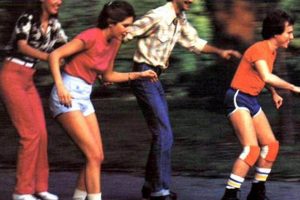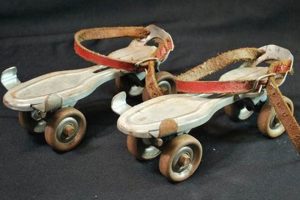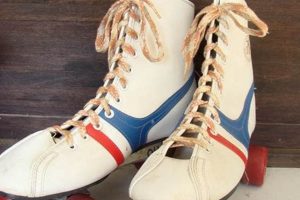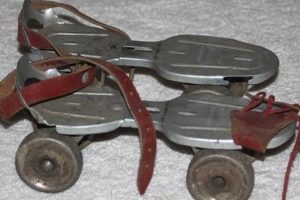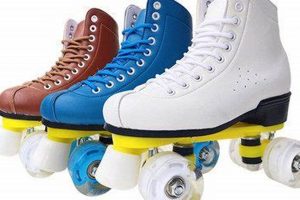Equipment designed for recreational and competitive skating, manufactured by Bont, enables users to move across surfaces with wheeled footwear. These specialized boots, often constructed with carbon fiber or fiberglass, are mounted on a frame that holds wheels, facilitating gliding and rolling motion. These products come in various models tailored for different skating disciplines, such as speed skating, roller derby, and artistic skating.
The performance and construction characteristics of this type of skating equipment can significantly affect a skater’s efficiency, speed, and control. Their rigid boot design, frequently heat-moldable, offers enhanced support and power transfer. Furthermore, the company’s historical commitment to innovation has influenced advancements in skating technology, impacting performance standards and pushing the boundaries of what is achievable in various skating sports.
The subsequent sections will delve deeper into specific aspects, including the different types available, factors to consider when selecting a pair, and maintenance tips to ensure longevity. This exploration aims to provide a thorough understanding of the key elements associated with choosing the right product for individual needs and skating goals.
Essential Guidelines for Optimizing Performance with High-Performance Skating Equipment
Proper utilization and maintenance are crucial for maximizing the lifespan and performance characteristics of high-performance skating equipment. The following guidelines offer valuable insights into ensuring optimal functionality.
Tip 1: Heat Molding for Customized Fit: Employ the heat molding process, as instructed by the manufacturer, to achieve a personalized fit. A well-fitted boot enhances power transfer and minimizes discomfort during extended use. Follow the manufacturer’s guidelines precisely to prevent damage to the boot structure.
Tip 2: Wheel Selection Based on Surface: Choose wheel durometer and size according to the skating surface. Harder wheels are suitable for smooth surfaces, while softer wheels offer better grip on rougher terrain. Incorrect wheel selection can compromise speed and control.
Tip 3: Bearing Maintenance for Smooth Rolling: Regularly clean and lubricate bearings to maintain optimal rolling efficiency. Accumulated dirt and debris can impede bearing performance, reducing speed and increasing effort required for propulsion. Use a specialized bearing cleaner and lubricant for best results.
Tip 4: Frame Alignment for Stability: Ensure proper frame alignment to maintain stability and prevent uneven wear. Misaligned frames can lead to instability and inefficient skating. Consult a qualified skate technician for professional alignment services.
Tip 5: Boot Care for Longevity: Regularly clean the boot exterior with a damp cloth to remove dirt and grime. Perspiration can degrade the boot materials over time. Allow the boots to air dry completely after each use to prevent bacterial growth and odor.
Tip 6: Secure Fastenings: Check all buckles, straps, and laces before each use. Ensure they are securely fastened to prevent slippage or loosening during skating. Loose fastenings can lead to instability and potential injury.
Adhering to these guidelines will contribute to improved skating performance, extended equipment lifespan, and enhanced overall skating experience. Proper care is essential for realizing the full potential of this specialized sporting equipment.
The subsequent section will address the various types of skating disciplines that benefit from the use of this equipment, alongside specific model recommendations for each.
1. Boot construction materials
Boot construction materials constitute a critical determinant of performance characteristics within the spectrum of equipment offered by Bont. The materials employed directly influence support, weight, and responsiveness, subsequently impacting a skater’s agility and efficiency.
- Carbon Fiber Composites
Carbon fiber composites provide an exceptional strength-to-weight ratio. Their inherent rigidity facilitates efficient energy transfer during push-off, minimizing energy loss and maximizing speed. Boots utilizing carbon fiber are frequently preferred in speed skating where even minor gains yield competitive advantages. However, the rigidity can reduce comfort over extended periods, necessitating precise fit.
- Fiberglass Composites
Fiberglass composites offer a more compliant alternative to carbon fiber. They provide a balance between support and flexibility, enhancing comfort for recreational and artistic skating applications. While not as stiff as carbon fiber, fiberglass still provides adequate energy transfer for most skating styles. These materials are generally more cost-effective than carbon fiber, making them suitable for a broader range of users.
- Leather and Synthetic Uppers
Leather and synthetic materials constitute the outer layer of the boot, influencing comfort and durability. Leather conforms to the skater’s foot over time, offering a personalized fit. Synthetic materials offer resistance to water and abrasion. The choice between leather and synthetic depends on the intended use, with leather favoring comfort and synthetics prioritizing durability and weather resistance. These materials are often combined with internal padding for additional comfort.
- Heat-Moldable Resins
Heat-moldable resins integrated within the boot structure enable customization through heat application. This process allows the boot to conform precisely to the skater’s foot, eliminating pressure points and enhancing fit. Heat-moldable resins are often incorporated into both carbon fiber and fiberglass boots. This feature is particularly beneficial for skaters with unique foot shapes or those requiring a precise fit for optimal performance.
Material selection profoundly impacts the overall skating experience. The choice between carbon fiber, fiberglass, leather, synthetic materials, and heat-moldable resins should align with the skater’s intended discipline, performance goals, and comfort preferences to optimize performance and minimize fatigue.
2. Frame Mounting System
The frame mounting system represents a critical interface between the boot and frame, directly influencing the energy transfer, stability, and overall performance characteristics of this skating equipment. The system dictates how the frame is affixed to the boot, influencing responsiveness and maneuverability. Frame mounting systems come in a few industry standards that influence the performance of Bont products.
- Two-Point Mounting (165mm/195mm)
The two-point mounting system employs two longitudinal slots for frame attachment, positioned at either 165mm or 195mm intervals. This configuration offers a relatively simple and lightweight design. This system is commonly found on entry-level to mid-range skate models, providing adequate stability for recreational skating and introductory racing. The limited adjustability can pose challenges for skaters seeking precise frame placement to optimize their individual skating technique.
- Three-Point Mounting
The three-point mounting system utilizes three attachment points, typically arranged in a triangular configuration. This design enhances rigidity and provides superior energy transfer compared to two-point systems. The added stiffness is beneficial for speed skating and high-performance applications where maximizing power output is paramount. However, this system may limit compatibility with frames from other manufacturers and can be more complex to adjust.
- Adjustability and Customization
Certain frame mounting systems incorporate lateral and longitudinal adjustability, allowing skaters to fine-tune frame placement according to their individual anatomy and skating style. This adjustability is particularly valuable for addressing pronation or supination issues, or for optimizing frame position for specific skating disciplines. Customization options contribute to improved comfort, reduced fatigue, and enhanced performance. Precision adjustment scales are incorporated on high end models.
- Material Compatibility
The boot and frame materials must be compatible to ensure a secure and reliable connection. Carbon fiber boots often require specific mounting hardware and techniques to prevent damage. Frame mounting systems should be designed to distribute stress evenly across the boot and frame to avoid potential failures. Careful consideration of material compatibility is essential for long-term durability and safety.
The selection of a frame mounting system is intrinsically linked to the skater’s discipline, skill level, and performance aspirations. Choosing the appropriate mounting system ensures efficient power transfer, stability, and customization capabilities, ultimately optimizing the skating experience with this specialized equipment. Incorrect selection of frame or boot by skater can be detrimental to skater’s future training. Careful selection is key to improve performance.
3. Wheel Durometer Options
Wheel durometer, measured on the A scale, signifies a crucial parameter influencing performance characteristics. The specific durometer rating of a wheel directly impacts grip, roll, and wear resistance, thus playing a pivotal role in the suitability of this skating equipment for diverse surfaces and skating styles.
- Grip vs. Roll Trade-off
Softer wheels, characterized by lower durometer values (e.g., 83A-85A), offer enhanced grip, particularly advantageous on slick or uneven surfaces. This increased grip facilitates sharper turns and improved control, especially beneficial in roller derby and artistic skating. Conversely, harder wheels (e.g., 88A-90A+) exhibit reduced rolling resistance, enabling faster speeds on smooth surfaces. Speed skaters commonly favor harder wheels for maximizing velocity. The choice represents a deliberate trade-off between grip and roll, guided by the intended application.
- Surface Compatibility
The optimal wheel durometer is contingent upon the skating surface. Softer wheels excel on outdoor surfaces, absorbing vibrations and maintaining grip on asphalt or concrete. Harder wheels, however, are more suitable for indoor skating rinks or smooth concrete surfaces, maximizing roll efficiency and minimizing energy loss. Using an inappropriate durometer can lead to reduced performance, premature wheel wear, and compromised safety.
- Wheel Wear and Durability
Wheel durometer also affects wear rate and durability. Softer wheels tend to wear down more quickly, especially on abrasive surfaces, necessitating more frequent replacements. Harder wheels exhibit greater wear resistance, offering extended lifespan, particularly on smooth indoor surfaces. Skaters should consider the trade-off between grip, roll, and wheel longevity when selecting a durometer rating.
- Discipline-Specific Considerations
Different skating disciplines necessitate varying durometer preferences. Speed skaters typically prioritize harder wheels for maximizing speed and minimizing rolling resistance. Roller derby skaters often favor softer wheels for enhanced grip and maneuverability in tight spaces. Artistic skaters require a balance of grip and roll for executing complex maneuvers. These distinct requirements underscore the importance of selecting a wheel durometer tailored to the specific demands of each skating discipline.
The diverse range of wheel durometer options available for this skating equipment underscores the importance of informed selection. Skaters must carefully consider their skating environment, style, and performance goals to optimize their wheel choice and maximize their overall skating experience. Mismatching these elements of equipment can have severe and detrimental effects to performance and longevity.
4. Bearing Precision Rating
Bearing precision rating constitutes a fundamental aspect of this skating equipment, directly influencing the efficiency and smoothness of wheel rotation. The rating, often specified using the Annular Bearing Engineers’ Committee (ABEC) scale, dictates the tolerances and manufacturing standards applied to bearing construction.
- ABEC Scale and Its Significance
The ABEC scale, ranging from ABEC 1 to ABEC 9, quantifies the dimensional tolerances of bearings. Higher ABEC ratings indicate tighter tolerances, resulting in reduced friction and improved rolling efficiency. However, ABEC ratings primarily address manufacturing precision and do not encompass factors such as material quality, lubrication, or bearing design, which also contribute significantly to overall performance. The common misconception is that a higher ABEC rating equates to superior speed, but it primarily indicates a higher level of manufacturing precision.
- Impact on Rolling Efficiency
Bearings with higher precision ratings facilitate smoother and more consistent wheel rotation, minimizing energy loss due to friction. This translates to increased speed and reduced effort for the skater. However, the performance gains diminish at higher ABEC ratings, with the difference between ABEC 7 and ABEC 9 bearings often being marginal for most skating applications. Rolling efficiency is further influenced by the bearing’s internal design, lubrication, and seal type.
- Bearing Material and Durability
Bearing materials, such as steel or ceramic, impact durability and resistance to corrosion. Ceramic bearings, while more expensive, offer lower friction and increased lifespan compared to steel bearings, particularly in demanding conditions. The choice of bearing material should align with the skater’s intended environment and usage intensity. Stainless steel materials will also improve bearing lifespan. Proper maintenance, including cleaning and lubrication, is critical for maximizing bearing lifespan regardless of material.
- Maintenance and Longevity
Regardless of the bearing precision rating, proper maintenance is crucial for preserving performance and extending lifespan. Regular cleaning and lubrication remove dirt and debris that impede rotation and accelerate wear. Different lubricants are available, each optimized for specific skating conditions. Neglecting maintenance can negate the benefits of high-precision bearings, resulting in reduced speed and premature failure. Routine upkeep is a key factor when using Bont roller skates or any other skating product.
Bearing precision rating is one factor when selecting skates. It must be considered in conjunction with material quality, maintenance practices, and the specific demands of the skating discipline. While higher ABEC ratings can contribute to improved rolling efficiency, they do not guarantee superior performance without proper care and attention to other critical bearing attributes.
5. Heat moldability feature
Heat moldability, an integral component of Bont roller skates, enables a customized fit achieved through the application of heat. This feature directly impacts comfort and performance by allowing the boot to conform precisely to the contours of the skater’s foot. When heated, the boot’s resin-impregnated materials soften, permitting manipulation and molding to eliminate pressure points and accommodate anatomical variations. For instance, skaters with bunions or other foot deformities benefit significantly from heat moldability, as it allows for personalized adjustments to alleviate discomfort and prevent potential injuries. The process is typically carried out using a convection oven or a specialized heat gun, following manufacturer-specified temperature and time guidelines.
The importance of heat moldability extends beyond simple comfort; it also contributes to enhanced power transfer and control. A snug, conforming fit minimizes slippage within the boot, maximizing the efficiency of each stride. Case studies involving speed skaters have demonstrated that properly heat-molded boots result in improved stability and reduced energy expenditure, leading to faster lap times. Furthermore, in roller derby, where agility and responsiveness are paramount, heat moldability facilitates a more secure and precise connection between the skater’s foot and the skate, enabling quicker reactions and more effective maneuvers. The feature empowers users to optimize their equipment for peak performance, minimizing distractions caused by ill-fitting boots.
While heat moldability offers substantial benefits, adherence to the manufacturer’s instructions is crucial to avoid damaging the boot’s structural integrity. Overheating or improper molding techniques can compromise the materials, leading to premature wear or failure. The feature represents a significant advancement in skating technology, providing a personalized fit previously unattainable with traditional skate designs. The practical significance lies in its ability to enhance comfort, improve performance, and extend the lifespan of the equipment, ultimately contributing to a more enjoyable and productive skating experience.
6. Closure mechanism design
The closure mechanism on Bont roller skates is not merely a fastening system; it directly impacts fit, support, and performance. The design influences how securely the boot conforms to the foot, affecting power transfer, stability, and overall comfort during skating. Different closure systems cater to various skating disciplines and user preferences, necessitating a nuanced understanding of their respective strengths and weaknesses.
- Lace Systems
Traditional lace systems provide a highly customizable fit by allowing skaters to adjust tension across different areas of the foot. This adaptability is beneficial for individuals with unique foot shapes or those seeking specific support levels in particular zones. However, laces can be time-consuming to adjust and may loosen during extended use, requiring periodic re-tightening. Laces are an industry standard for many products including roller skates. They work very well with Bont roller skates.
- Buckle Systems
Buckle systems offer a combination of security and convenience. They provide a secure and consistent fit with minimal effort, making them suitable for skaters who prioritize ease of use. Micro-adjustable buckles allow for fine-tuning of the fit, ensuring a snug and comfortable feel. However, buckle systems may offer less customization compared to laces, and buckle breakage can render the skate unusable until repaired.
- Velcro Straps
Velcro straps provide a quick and easy closure option, particularly well-suited for entry-level skates or skaters who prioritize speed and convenience. While velcro straps are easy to fasten and adjust, they may not offer the same level of security or support as laces or buckles. Over time, velcro straps can lose their effectiveness due to wear and tear, requiring replacement to maintain a secure fit.
- Hybrid Systems
Some Bont roller skate models utilize hybrid closure systems, combining elements of laces, buckles, and velcro straps to achieve a balance of customization, security, and convenience. These systems aim to leverage the strengths of each closure type, offering a versatile solution for diverse skating styles and preferences. For example, a combination of laces in the forefoot and a buckle at the ankle provides both precise fit and secure ankle support.
The selection of a closure mechanism is an essential element in choosing Bont roller skates, influencing not only the ease of use but also the overall performance and comfort. Skaters must consider their individual needs, skating discipline, and preferences when selecting a closure system to ensure a secure and efficient skating experience. Incorrect closure system will impact skater’s training significantly.
7. Discipline-specific models
Bont’s design philosophy acknowledges the divergent demands imposed by various skating disciplines, directly influencing its product line. The company manufactures specialized models tailored for speed skating, roller derby, artistic skating, and recreational skating. Each discipline-specific model reflects targeted engineering, adjusting boot stiffness, frame configuration, wheel placement, and closure systems to optimize performance within the intended context. For instance, speed skating models prioritize energy transfer and aerodynamic efficiency, typically incorporating rigid carbon fiber boots and streamlined frame designs. Roller derby models, in contrast, emphasize agility and maneuverability, often featuring lower-cut boots and shorter wheelbases. This tailored approach ensures skaters can maximize their potential within their chosen skating form.
The implementation of discipline-specific models represents a practical response to the multifaceted requirements of different skating styles. Examples include the Bont Z model for speed skating, known for its exceptional stiffness and power transfer, and the Bont Quadstar for roller derby, designed for agility and responsiveness in confined spaces. The selection of an inappropriate model for a given discipline can directly impede performance, leading to decreased efficiency and increased risk of injury. Therefore, understanding the specific features and intended application of each model is crucial for skaters seeking to optimize their training and competitive outcomes. Furthermore, discipline-specific designs can assist skaters in specialized training. Bont has various training systems for all skating levels.
In summary, the connection between discipline-specific models and the overarching Bont product line underscores the importance of tailored engineering in optimizing skating performance. The commitment to specialized designs reflects a recognition that a one-size-fits-all approach is inadequate for addressing the diverse needs of the skating community. The practical significance of this understanding lies in the ability to make informed equipment choices, maximizing potential, and minimizing risks associated with mismatched or poorly suited skating equipment. Improper choices will lead to improper training.
Frequently Asked Questions About bont roller skates
This section addresses common inquiries regarding equipment manufactured by Bont, providing concise and informative answers to assist in the selection and maintenance process.
Question 1: What distinguishes Bont roller skates from other brands?
Bont differentiates itself through its emphasis on anatomical design, heat-moldable boots, and discipline-specific models. The company’s commitment to customized fit and performance-oriented features distinguishes it from brands offering generic, mass-produced products.
Question 2: How does one determine the appropriate size when purchasing Bont roller skates online?
Consult the manufacturer’s sizing chart, which provides measurements for both length and width. Measure the foot in millimeters, wearing socks typically worn during skating. Compare these measurements against the chart to identify the corresponding size. Note that sizing may vary slightly between different models.
Question 3: What is the recommended procedure for heat molding Bont roller skates?
Preheat the oven to the temperature specified by the manufacturer (typically between 70C and 80C). Remove the wheels and bearings. Place the boots in the oven for the duration indicated by the manufacturer. Once heated, carefully put on the boots and lace them snugly. Allow the boots to cool while seated, maintaining the skating posture. Follow the manufacturer’s instructions precisely to avoid damaging the boot.
Question 4: How often should one replace the wheels on Bont roller skates?
Wheel replacement frequency depends on skating frequency, surface conditions, and wheel durometer. Inspect the wheels regularly for wear. Replace the wheels when they exhibit significant wear, such as a flattened profile or a diameter reduction exceeding 5mm. Uneven wear can compromise performance and safety.
Question 5: What type of maintenance is required for the bearings in Bont roller skates?
Bearings require periodic cleaning and lubrication to maintain optimal performance. Remove the bearings from the wheels. Clean them with a specialized bearing solvent. Allow the bearings to dry completely before applying a suitable lubricant. Over-lubrication can attract dirt and debris, so apply sparingly. Regular maintenance prolongs bearing life and ensures smooth rolling.
Question 6: Can Bont roller skates be used for both indoor and outdoor skating?
Certain Bont models are designed for both indoor and outdoor use. Select models with wheels appropriate for the intended surface. Softer wheels are better suited for outdoor skating, while harder wheels are preferable for smooth indoor surfaces. Inspect the skates regularly for damage after outdoor use, paying particular attention to the wheels and bearings.
Understanding these key points will contribute to a more informed decision-making process when selecting and maintaining your skating equipment.
The subsequent section will cover tips and tricks to improve your overall skating ability with Bont roller skates.
Concluding Observations on Professional Skating Equipment
The preceding analysis has explored diverse facets of professional skating equipment manufactured by Bont, encompassing design elements, performance attributes, and maintenance considerations. Critical aspects include boot construction materials, frame mounting systems, wheel durometer options, bearing precision ratings, heat moldability features, closure mechanism designs, and discipline-specific models. A comprehensive grasp of these variables is crucial for informed purchasing decisions and optimized equipment utilization. Precise specification is key when considering professional skating equipment.
The long-term value derived from these products hinges on responsible selection, diligent maintenance, and a commitment to adhering to manufacturer guidelines. Continued innovation within the skating industry promises further advancements in equipment technology, potentially unlocking new performance capabilities. It is imperative to remain abreast of these developments to fully capitalize on the evolving landscape of professional skating equipment.


